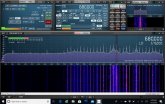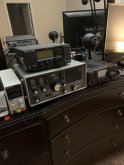hagensieker
Solar Enthusiast
- Joined
- Jan 30, 2020
- Messages
- 136
I've really been around and around trying to figure out how to have a relatively noise free environment while running a solar inverter and shortwave radios at the same time.
The first conclusion I have come to is for small radios with their own aerial in the same or next room as the inverter..........you can't. It is simply too noisy on AM radio and lower short wave bands.
I started with a Giandel 2000 watt and it was terrible with RF emissions. It sprayed RF all over the place.
Then I read that Samlex Inverters were way better with RF. So I dropped $550 for one. Once again my AM bedside radio was blasted with RF. Unusable. Then I hooked that radio to an outdoor antenna and it was greatly improved.
Then instead of using a shortwave radio (I have MANY) I used a shielded RTL-SDR device. An SDRPlay RSPdx. Then I hooked it to an outdoor antenna and there is almost no RF interference at all. All you can see are the signals in the pic below. No hash or interference or floor noise much between the signal peaks.

By the way, how many of you know that AM radio signals travel for hundreds and sometimes thousands of miles at night? There are a lot of high power (clear channel, 50,000 watts) radio stations.
At any rate here is what I have learned in a nutshell.
- The Samlex inverters are way better than Giandel as it relates to RF emissions.
- Better does not mean perfect. A nearby AM radio or shortwave radio up to about 7 MHz with an indoor aerial will experience severe interference.
- A shielded RTL-SDR device can eliminate most of the remaining RF interference.
- I have several shortwave receivers and best results are obtained when the Solar Inverter is turned off when I am trying to dig signals out of the muck. They are quite useable above 5 MHz 99% of the time. Also as an interesting note the power supply at the left of the picture below is really noisy as it relates to RF as well. I have it hooked to one radio as a power source. Bad idea.

- While it is fun to play with the old shortwave radios, in a grid down situation when the solar HAS TO POWER THEM, an RTL-SDR device will need to be used. For the most part the SDR's are technically superior to the old boat anchors but not as much fun.
- Need to get some ferrite chokes to see if the RF can be reduced further.
- Greater distance to the antenna improves the situation.
The first conclusion I have come to is for small radios with their own aerial in the same or next room as the inverter..........you can't. It is simply too noisy on AM radio and lower short wave bands.
I started with a Giandel 2000 watt and it was terrible with RF emissions. It sprayed RF all over the place.
Then I read that Samlex Inverters were way better with RF. So I dropped $550 for one. Once again my AM bedside radio was blasted with RF. Unusable. Then I hooked that radio to an outdoor antenna and it was greatly improved.
Then instead of using a shortwave radio (I have MANY) I used a shielded RTL-SDR device. An SDRPlay RSPdx. Then I hooked it to an outdoor antenna and there is almost no RF interference at all. All you can see are the signals in the pic below. No hash or interference or floor noise much between the signal peaks.

By the way, how many of you know that AM radio signals travel for hundreds and sometimes thousands of miles at night? There are a lot of high power (clear channel, 50,000 watts) radio stations.
At any rate here is what I have learned in a nutshell.
- The Samlex inverters are way better than Giandel as it relates to RF emissions.
- Better does not mean perfect. A nearby AM radio or shortwave radio up to about 7 MHz with an indoor aerial will experience severe interference.
- A shielded RTL-SDR device can eliminate most of the remaining RF interference.
- I have several shortwave receivers and best results are obtained when the Solar Inverter is turned off when I am trying to dig signals out of the muck. They are quite useable above 5 MHz 99% of the time. Also as an interesting note the power supply at the left of the picture below is really noisy as it relates to RF as well. I have it hooked to one radio as a power source. Bad idea.

- While it is fun to play with the old shortwave radios, in a grid down situation when the solar HAS TO POWER THEM, an RTL-SDR device will need to be used. For the most part the SDR's are technically superior to the old boat anchors but not as much fun.
- Need to get some ferrite chokes to see if the RF can be reduced further.
- Greater distance to the antenna improves the situation.




